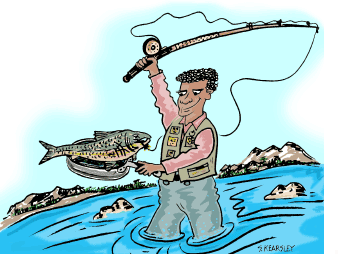|
Monthly Feature:


If you're keen to master the art of cooking fish, it's worth noting a couple of major differences between fish and meat. Look closely at a filet of fresh salmon, cod, or halibut, and you'll see pearly webbing between the striations of muscle. This is the connective tissue called "collagen," a structural protein that holds together short, thick muscle fibers. In fish, muscle fibers are much shorter than they are in beef, and collagen dissolves easily during cooking. So fish cooks quickly and there's no tenderizing to do. In fact, the biggest challenge in preparing fish filets is to keep them from falling apart after cooking.
As fish cooks, proteins in the muscle fibers coagulate and the flesh changes from translucent to opaque in appearance. When the collagen softens in heat, it loses its structure and turns to gelatin; the muscle fibers have little to hold them together and the fish separates easily into flakes. The processes of fibers coagulating and collagen softening happen almost simultaneously, and at lower temperatures than with beef. So it's easy to understand why fish is easily overdone.
To keep the tissues from drying during cooking, fish requires higher temperatures and shorter cooking times than meat. A general rule of thumb for cooking is 10 minutes per inch of thickness, but this varies according to cooking method, heat intensity, and fish size. Use a cooking thermometer to gauge doneness more precisely. Fish is cooked when a thermometer (we recommend the slender digital kind) inserted into the thickest part of the flesh reaches 140° F.
Doneness, however, is also easy to see, so careful observation gives some definite clues. When you think it's almost done, insert a small paring knife into the center of the flesh to see if the translucency is almost gone. This applies whether you're poaching, grilling, or baking.
Then the transition from "almost done" to perfectly cooked happens in minutes. Remember that residual heat means the fish continues to cook for a few minutes, even after it is removed from the heat.
Fish that seems tough when you bite into it is probably overcooked. As it moves from done to "overdone," the flesh continues to firm then shrinks, pushing out moisture, which evaporates and leaves the fish dry and chewy.
Fresh fish needs little embellishment, for its flavor is as fragile as its flesh. To enhance is ideal; to overpower spoils a delicate and memorable treat. Keep it simple. A sprinkle of salt. Some freshly ground pepper. A squeeze of fresh lemon. Perhaps a few fresh herbs. It seems that cooking fish beautifully rests on science as well as the art of restraint. As to your enjoyment, however, happily indulge. For few foods need as little preparation to be outstanding.
|
